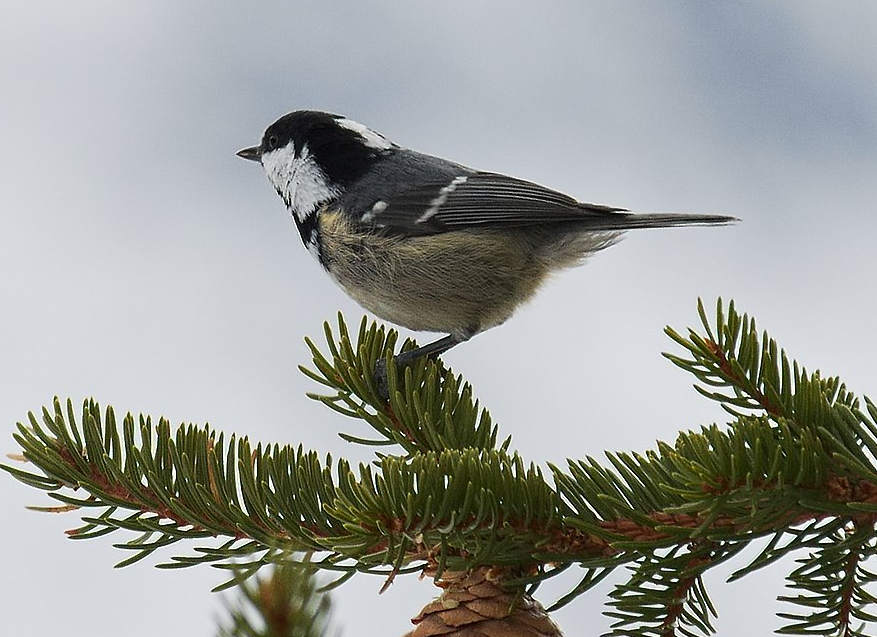Garden Wildlife
Garden Wildlife


What do they look like?
Built like the other common tits, the coal tit has a rather big head for its body. The most striking feature is the black cap and bib, with a distinctive and prominent white patch on the nape, setting off a white face and creamy body with tinged pinkish flanks. The wings and back are grey-looking, with a pair of white stripes on the wings. See our tits page to compare with other species.
What do they sound like?
Given their preference for conifer woods, coal tit songs are not often heard in gardens, but they sound a bit like great tits.
Coal Tit Periparus ater
Another top-tenner among garden birds, the Coal Tit is a slightly smaller (11.5cm), duller version of the great tit, but has its own distinctive charm both in appearance and behaviour. It tends to be commonest in conifer woods but in Winter certainly spreads out with other small birds in mixed flocks to investigate garden food sources.

.jpg)
What do they eat?
Like all the tits, coal tits are insectivorous most of the time, but they are also keen seed and fat eaters in winter when they visit garden feeders. They have the habit of flitting in, taking a seed and then flying off to eat it elsewhere, so visits to the feeding station may be fleeting.
What do they do?
In pinewoods coal tits spend a lot of their time in the treetops, using their fine bills to probe for insects. Like other tits they are agile and active. They nest in tree-holes and crevices, but are less likely than other tits to use nest boxes in gardens. They are sedentary in the UK apart from moving to lower levels in winter. They practice food-hoarding quite successfully, which means in much of their range (across the entire Northern regions of Eurasia from the Atlantic to the Pacific) they can survive in their breeding areas in winter.
How are they doing?
A glance at BTO Breeding Birds Survey 2019 suggests Coal Tits have a pretty stable UK population with about 680,000 territories. Thery may be increasing along the western fringes of these islands as more conifer plantations are established
Finding out more:
BTO profile on coal tit
RSPB profile on coal tit
Page written by Roy Smith, compiled by Steve Head
Dan Lombard, XC639840. Accessible at www.xeno-canto.org/639840
Alexander Henderson, XC628691. Accessible at www.xeno-canto.org/628691.
Coal Tit Periparus ater
Another top-tenner among garden birds, the Coal Tit is a slightly smaller (11.5cm), duller version of the great tit, but has its own distinctive charm both in appearance and behaviour. It tends to be commonest in conifer woods but in Winter certainly spreads out with other small birds in mixed flocks to investigate garden food sources.

.jpg)
What do they look like?
Built like the other common tits, the coal tit has a rather big head for its body. The most striking feature is the black cap and bib, with a distinctive and prominent white patch on the nape, setting off a white face and creamy body with tinged pinkish flanks. The wings and back are grey-looking, with a pair of white stripes on the wings. See our tits page to compare with other species.
What do they sound like?
Given their preference for conifer woods, coal tit songs are not often heard in gardens, but they sound a bit like great tits.
What do they eat?
Like all the tits, coal tits are insectivorous most of the time, but they are also keen seed and fat eaters in winter when they visit garden feeders. They have the habit of flitting in, taking a seed and then flying off to eat it elsewhere, so visits to the feeding station may be fleeting.
What do they do?
In pinewoods coal tits spend a lot of their time in the treetops, using their fine bills to probe for insects. Like other tits they are agile and active. They nest in tree-holes and crevices, but are less likely than other tits to use nest boxes in gardens. They are sedentary in the UK apart from moving to lower levels in winter. They practice food-hoarding quite successfully, which means in much of their range (across the entire Northern regions of Eurasia from the Atlantic to the Pacific) they can survive in their breeding areas in winter.
How are they doing?
A glance at BTO Breeding Birds Survey 2019 suggests Coal Tits have a pretty stable UK population with about 680,000 territories. Thery may be increasing along the western fringes of these islands as more conifer plantations are established
Finding out more:
Page written by Roy Smith, compiled by Steve Head
























